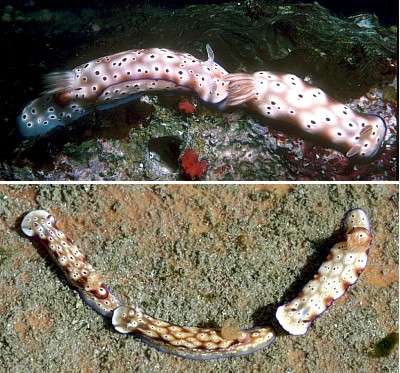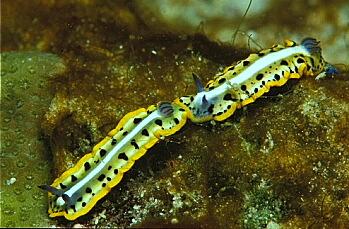

Trailing behaviour
PHOTO
Upper: Two Risbecia tryoni, Kwajalein Atoll. Photo: Scott Johnson. Centre: Three Risbecia tryoni, Enewetak Atoll. Photo: Scott Johnson. Lower: Chromodoris kempfi Bonaire, Netherlands Antilles, August 2002. Photo: Andreas Ahrens
Also known as queueing or tail-gating, all species of the chromodorid genus Risbecia exhibit this behaviour where they seem to play "follow the leader". Perhaps its a behaviour which has evolved amongst relatively uncommon animals to ensure they find each other for mating. When tailing, one animal appears to follow the mucous trail of the other until they actually make contact. Then the following animal, as can be seen in thse photos, keeps contact by touching the 'tail' of the leader. Sometimes 3 or 4 animals can be seen together.
I suggested years ago that this behaviour could be used as a distinguishing character for the genus Risbecia, but we now know that the Caribbean species 'Chromodoris' kempfi and the Indo-West Pacific species Hypselodoris paulinae also does the same thing.
Two messages om the Forum, one from Stuart Hutchison and the other from Mike Miller, report R. tryoni and the yellow-spotted Risbecia pulchella either trailing each other, or in close contact, suggesting that the chemical attractant driving this behaviour may be very similar in both species.
Other groups of opisthobranchs show similar behaviours, including aplysiids, aglajiids, and onchidorids.
See messages on the following pages for further photos of trailing:
• Risbecia ghardaqana
• Risbecia godeffroyana
• Risbecia imperialis
• Risbecia pulchella
• Risbecia tryoni
• Chelidonura varians
• Chelidonura inornata
• Chelidonura punctata
• Stylocheilus striatus
• Onchidoris bilamellata, message 2.
• Acanthodoris nanaimoensis
• Platydoris striata
• Phyllodesmium magnum, message 2
Authorship detailsRudman, W.B., 2003 (March 5) Trailing behaviour. [In] Sea Slug Forum. Australian Museum, Sydney. Available from http://www.seaslugforum.net/factsheet/trailing
